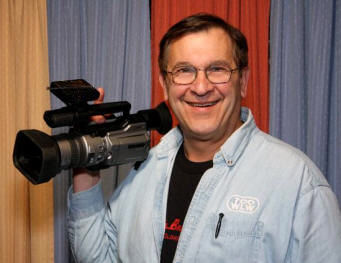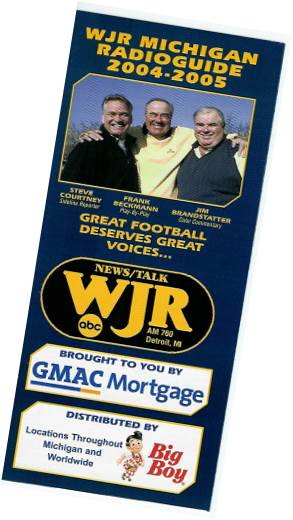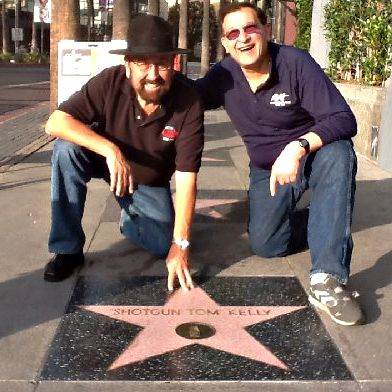One of the best parts of working in the radio industry is the truly unique people you meet. While there must be interesting CPAs and dentists, the number of real characters per capita at radio stations has to statistically be significantly higher than most other businesses.
And then there’s Art Vuolo, or as many of you know him, “Radio’s Best Friend.”
 While most of the curious and fascinating people in radio spend their time in the studio on the air, some are on the periphery of the business, defying categorization, following their own path, and carving out a unique niche for themselves in the industry.
While most of the curious and fascinating people in radio spend their time in the studio on the air, some are on the periphery of the business, defying categorization, following their own path, and carving out a unique niche for themselves in the industry.
That’s Art, who has spent a lot of time with the former group and is a charter member of the latter. He has become radio’s official video archivist – if there is such a thing – literally focusing on what really happens in the air studio, and also at radio’s many conventions and conferences.
Back in 1978, Art borrowed equipment to record his first “video aircheck,” recording the hosts at Indianapolis’ legendary Top 40 radio station 13/WIFE. At a time when there were no audio streams or any way of seeing DJs – except with pictures in the trades – Art’s videos became one of the only ways aspiring broadcasters could see and hear what was happening at stations in other markets.
Over the years, his collection has grown to massive proportions with hundreds of audio and video tapes chronicling the best and brightest in radio. (The video embedded in this post below is an amazing compilation of radio stars and icons from yesteryear, providing a video collage of how radio became RADIO.) Art also began recording keynotes, panels, and sessions at myriad radio conventions, creating an archive of radio’s leaders discussing the challenges of the day as the industry continues to evolve. From Convergence to DASH to Conclave to the Worldwide Radio Summit, Art and his ubiquitous camera are always there.
Between his time in-studio and attending nearly umpteen conferences over the last 30 years, Art has had a bird’s eye view of the industry that no one can match. It makes you wonder about who’s going to chronicle the radio broadcasting industry and its talent after Art decides to cap the lens one final time.
After all these years of pointing the lens at us, it’s time for radio to turn the focus on him. Art Vuolo provides a service to the radio broadcasting industry that is truly unique, which is why he’s this week’s Radio’s Most Innovative.
JM: How did you get the title “Radio’s Best Friend?”
AV: I am very proud of the moniker which was actually given to me by Scott Shannon in the early 1980s. It first appeared in print in May 1985, courtesy of John Leader, who wrote “Street Talk” in Radio & Records, congratulating me on a big sponsorship by General Motors of my Rock RADIOGUIDE. My old company, The RADIOGUIDE People, Inc., was responsible for the national circulation of over 100 million station directories in concert with many of America’s greatest stations. They were sponsored by clients like Ford Motor Company, United Airlines, and National Car Rental.
 JM: How many years did you publish the RADIOGUIDE?
JM: How many years did you publish the RADIOGUIDE?
AV: My RADIOGUIDE business lasted from 1971 through 2004 – 33 years. The idea was hatched during my college days when classmates wanted me to mark up their road maps with the good rock stations from Michigan down to Florida for Spring Break. I kept my Chicago-based printer going strong for many years. Every guide had a sponsor who paid for it, a radio station who promoted it on the air, and a multi-location retailer who distributed it free of charge. It worked well, but then the Internet came along.
JM: How did your love for radio develop?
AV: My “wonder years” – ages 5-16 – were spent in Indianapolis. Like so many, it started with a small crystal radio under the pillow, falling asleep every night listening to Bernie Herman on Night-Beat over 1430/WIRE. Then, I started assisting and became close friends with Indiana’s top radio personality, Jim Shelton at WIBC in Indy. He was my mentor. I always had a radio nearby. I still do.
JM: How did you get started doing video airchecks?
AV: I saw a video profile of B-100 San Diego, produced on 8mm film, by the legendary Shotgun Tom Kelly at the 1977 R&R Convention in Dallas, and went crazy! I thought, “Wow, a VIDEO aircheck…how cool.” That did it. Two years later, I recorded creative news personality Rob Milford at KWK in St. Louis. In 1979, I did a video profile of 13 WIFE in Indianapolis with close friend and PD, Steve Cooper (aka Jim Carr). Since 1979, I’ve shot hundreds of DJs and have yet to be convicted.
JM: Who is the most innovative talent you ever captured on videotape? What made them stand out to you?
AV: Just about everyone knows that I am a huge fan of Bob & Tom, so they top the list. Others would include members of the Morning Zoo at Z-100 in the ‘80s, Paul & Young Ron at Miami’s WBGG, all the Chicago WLS icons I captured at the various WLS Reunions, and of course, the energetic Shotgun Tom and Tom Kent, two of radio’s last exciting personalities.
JM: Your website says “No one has more videotape of Bob and Tom.” What has made their show so successful and sustainable all these years?
AV: Bob and Tom, along with their cast members, Chick McGee and Kristi Lee, fill their studio almost every morning with comedians and it makes for a very explosive package of non-stop laughs. And Bob has the best laugh in radio. Tom is an easy target and they’ve done more to help comics and charitable causes across America than anyone in radio.
JM: What is the most memorable radio conference moment you ever filmed? Why was it so special?
AV: There are a few that come to mind. On March 15, 2003, I was the only person to record Paul Harvey’s 17 minute keynote at the R&R Talk Radio Seminar in L.A. As it turned out, it was his last address to the radio industry.
The other was a riveting keynote by Minnie Pearl at the 1989 Country Radio Seminar in Nashville. She explained how the legendary WSM call letters stood for “We Shield Millions,” the slogan of the insurance company which originally owned the station.
I’d have to also include the 1998 induction of 25 of radio’s most famous jocks at the Rock & Roll Hall of Fame. Legends like Dick Biondi, Bruce Morrow, Dan Ingram, Joey Reynolds, Jerry Blavat, and Martha Jean the Queen were there and I was the only one to videotape the event.
JM: What is the most requested tape in your library?
AV: That one is a slam-dunk. My two-hour video, “Memories of WCBS-FM,” made as a suggestion of former CBS-FM PD Dave Logan after the station became Jack-FM. When David Hinckley mentioned it in the New York Daily News, I initially received over 500 requests for the DVD. In total, nearly 1,000 copies have been circulated nationwide, and it features in-studio video of Harry Harrison, Ron Lundy, Dan Ingram, Cousin Brucie and many others.
JM: What is the best thing that has happened to the radio industry since you’ve been involved? And what’s the worst?
AV: Topping the list would have to be the way radio came together on September 11, 2001. It is visually depicted in a short 13 minute mini-documentary I produced called “NYC Radio 9-11” and is available on YouTube. I would like to see more unification of the industry like that, versus the polarizing division created by most political-leaning talk radio.
The worst thing is tough. Voice-tracking was developed to bring major market sounding talent to smaller market stations, but has become a crutch because it’s cheap and easy, which is part of the root problem: consolidation. There are fewer people doing more jobs and watering down the product mostly due to big companies amassing too much debt. When the industry regularly enjoyed 5-10 percent revenue growth, many operators had no problem overpaying to increase their portfolio. Now we are all paying the price.
JM: What is the best innovation you’ve seen in the radio industry in recent years?
AV: Even though little, if any, revenue has been derived from stations streaming on the Internet, I love the fact that I can plug my iPhone into the auxiliary port of any car radio and hear great stations from all over America. As a kid who wondered in amazement at how many AM stations I could pull in after dark, this technology is phenomenal. I have an app called StreamS HiFi that lets me dial in my favorites from all the various radio groups. Luckily, I have an unlimited data plan.
JM: What’s the best piece of video you ever produced?
AV: The best compilation of my work can be found on YouTube in a 22 minute video entitled DJ Mini-Blitz v3.
JM: In a Radio & Records profile, you talked about working at WNIC in Detroit and realizing that you didn’t just want to work for one station, leading you to start your own business. What would you say to someone else who has that same desire but isn’t sure how to get started?
AV: It’s important to understand there are pros and cons. The upside is two-fold: when you work for yourself, you can’t get fired. And the F-word in my vocabulary is “flexibility.” I can work in my underwear (apologies for the visual). The downside is that you never know where your next dollar is coming from and you tend to work all the time. Just look around and you’ll see that many of the exceedingly talented people in radio who have left the industry due to down-sizing are now self-employed.
JM: You have amassed a huge collection of radio personalities on video. What is going to happen to all of it in the future?
AV: I have what most people feel is the largest archive of radio-oriented video and audio in the entire country. Two highly recognized people in our industry, John Gehron and Lisa Miller, are working diligently to find a home for this visual and aural history of radio at places like the Paley Media Center in New York or the Museum of Broadcast Communications in Chicago. Until that time, everything I have is still available on www.vuolovideo.com.
Thanks to Mike Stern for writing this week’s RMI.
INNOVATION QUOTE OF THE WEEK
“Grit is often the single-most predictor of success.”
Jonah Lehrer, author & journalist
More of Radio’s Most Innovative
- Radio’s Most Innovative: Dan Vallie, National Radio Talent System
- Radio’s Most Innovative: Greater Public’s Doug Eichten
- Radio’s Most Innovative: Mens Room Original Red
- Radio’s Most Innovative: Fun Kids
- Radio’s Most Innovative: One Year Later
- What To Do If Your Radio Station Goes Through A Midlife Crisis - April 25, 2025
- A 2020 Lesson?It Could All Be Gone In A Flash - April 24, 2025
- How AI Can Give Radio Personalities More…PERSONALITY - April 23, 2025





Great memories and such a class act. Great post! Way to go Art! (and of course, let us not forget the classic “repairing of the FJ power point recently at the conclave” Likely to be a Vuolo classic! 🙂
Thanks for the comment, Dave. Yes, it was fun playing with Art at Conclave. (He’s still trying to figure out how I did it.)
We don’t realize it, but Art has done the job that generations of “radio historians” should have done and documented the changing world of radio, the greatest personalities of all time, and people doing stupid things in front of a camera for most of our careers, even lives.
For an industry that is notorious for not keeping good historical context (how any vinyl records did YOU throw out in the dumpster at one point in your career?) Art has filled the void. None of us know how important saving history on video was back in the day, and Art has a New Media record of the world of radio unlike any other collection in any format.
Thank you, Art, for all that you’ve done, for taking mocking by some of the biggest names in show business in stride, and for devoting your life to something that means so much to so many people.
Mark, I think you’ve nailed it. This is precisely why Art deserves to the “innovation” tiara (OK, maybe crown). He has captured our business in a unique way that begs the question we asked in the post about how this information will be preserved for future generations. Thanks, Mark.
How many people do you know whose address book included Paul Harvey’s home phone number and he knew his wife by her first name? Art’s amazing and he has provided invaluable assistance in establishing my web site: http://www.YouTube.com/WatchmanOfTheTracks Plus,he agreed to have a special group of his programs posted to the site. My only wish is that Art would incorporate some “forward thinking” and draw plans for what will happen to his priceless collection when we all graduate to the studio in the sky. Stay tuned!
As Art mentioned near the end of the post, John Gehron and Lisa Miller are on the case. Hopefully, they will find a great home of Art’s archives. Thanks for the comment.
What a wonderfully written piece and how richly deserved. Art Vuolo is not only “Radio’s Best Friend.” He is simply — THE BEST!
Much appreciated, Pete. Art is truly one of radio’s great resources, providing a lasting view of its history. Thanks for commenting!
Art grew up in my hometown, and although I did not know him then, we unknowingly shared some of the same friends across the city. And Art’s videos have filled a strange purpose: my kids were in control rooms at a very young age, and do not remember those experiences. After I moved to management, they never saw the inside of a studio again. As they got older and Art’s videos appeared on the Internet, I have pointed them to various Art videos, and they have been able to see what goes on in a control room/studio in this crazy business, and what I once did.
Thanks, Chuck, for the recollection. Art is a video storyteller and your comment underscores the importance of his work.
Art is truly radio’s “national treasure.” Thank you for recognizing him as the innovator he has been and continues to be. He’s not only radio’s best friend, but he’s one of the nicest guys in radio I’ve ever had the pleasure to know.
Thanks for the kind words, Corinne. I know Art will appreciate that. And it’s great to hear from you!
Art Vuolo is a god-send. I worked in radio for many years, and have friends that know Art. Watching his old videos of air-checks is a trip back in time for me, from when radio was so much fun to work in. Now? No thanks. Now, I’m a smart-ass ranting, politically incorrect comic. Can’t do it on radio any longer, but hey, there’s the internet for folks like me. Love this so much. Randy McDaniels, TLC.
Randy, thanks for the note and the kind works about Art and his contributions to radio.
Art’s been a good and reliable friend for over 55 years since we were youngsters. He’s always a delight because he does a fantastic job of informing and teaching me about all the great personalities of radio history, particularly talk-radio. He’s a walking encyclopedia who, in my opinion adds huge value to the industry and its players. Thank you Art !,
Appreciate the comment, Chris. We are happy to honor Art in RMI.
I’ve known Art since very shortly after he moved to Michigan from Indianapolis: about 57 years! Everything covered in the article, I’ve seen at least some aspects of all his major projects from their birth.
I was able to give him corrections, additions, and deletions to his Radio Guides, en masse, during its earliest days in the 1970s, because at the time I had a near-photographic memory for radio station callsigns and formats. By the 1980s I could no longer do this, with the explosive number of new FM stations, and the full-speed-ahead migration of music formats from AM to FM.
Art has always taken pride in his avocation-become-vocation, and his expertise in editing and visual effects shows well. It’s a very good thing to know that he’s made arrangements for his heritage to carry on for many decades from now.